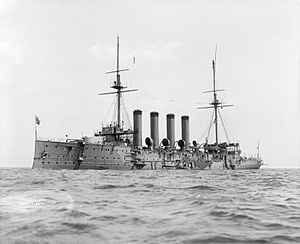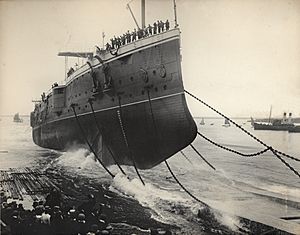HMS Hogue (1900) facts for kids

Hogue at anchor
|
|
Quick facts for kids History |
|
|---|---|
| Name | HMS Hogue |
| Namesake | Battle of La Hogue |
| Builder | Vickers, Sons & Maxim, Barrow-in-Furness |
| Laid down | 14 July 1898 |
| Launched | 13 August 1900 |
| Completed | 19 November 1902 |
| Fate | Sunk by U-9, 22 September 1914 |
| General characteristics | |
| Class and type | Cressy-class armoured cruiser |
| Displacement | 12,000 long tons (12,000 t) (normal) |
| Length | 472 ft (143.9 m) (o/a) |
| Beam | 69 ft 6 in (21.2 m) |
| Draught | 26 ft 9 in (8.2 m) (maximum) |
| Installed power |
|
| Propulsion |
|
| Speed | 21 knots (39 km/h; 24 mph) |
| Complement | 725–760 |
| Armament |
|
| Armour |
|
HMS Hogue was a large warship called an armoured cruiser. She was built for the Royal Navy (the British navy) around 1900. After she was finished, Hogue served in different parts of the world, like the Channel Fleet and the China Station.
Later, in 1906, she became a training ship for young sailors. She was then put into the reserve in 1908. When World War I began in 1914, Hogue was brought back into service. She took part in a small way in the Battle of Heligoland Bight. Sadly, Hogue was sunk by a German submarine called U-9 on 22 September 1914. Two of her sister ships were also sunk that day.
Contents
Ship Design and Features
Hogue was a big ship, weighing about 12,000 tonnes (which is 12,000 long tons). She was about 472 feet (143.9 m) long, 69 feet 6 inches (21.2 m) wide, and sat 26 feet 9 inches (8.2 m) deep in the water.
Engines and Speed
The ship had two powerful 4-cylinder triple-expansion steam engines. These engines made a total of 21,000 indicated horsepower (16,000 kW) (indicated horsepower). They used steam from 30 large Belleville boilers. The engines were designed to make the ship go up to 21 knots (39 km/h; 24 mph) (knots). During her tests at sea, Hogue actually reached a speed of 22.06 knots (40.86 km/h; 25.39 mph). The ship could carry up to 1,600 long tons (1,600 t) of coal for fuel. She had a crew of about 725 to 760 officers and sailors.
Weapons and Protection
Hogue's main weapons were two large 9.2-inch (234 mm) guns. One was at the front of the ship and one at the back. These guns could fire 380-pound (170 kg) shells up to 15,500 yards (14,200 m) away.
She also had twelve 6-inch (152 mm) guns. These were placed in special armoured rooms along the sides of the ship. Eight of these guns were on the main deck, but they could only be used when the sea was calm. They could fire 100-pound (45 kg) shells about 12,200 yards (11,200 m).
For protection against smaller, faster ships like torpedo boats, Hogue had twelve smaller 12-pounder ([convert: unit mismatch]) quick-firing guns. She also carried three even smaller 3-pounder ([convert: unit mismatch]) guns. In addition, the ship had two torpedo tubes hidden underwater. These could launch 18-inch (457 mm) torpedoes.
The ship was protected by thick metal plating, called armour. The armour belt along the waterline was up to 6 inches (152 mm) thick. The gun turrets and their bases had 6 inches (152 mm) of armour. The armoured rooms for the 6 inches (152 mm) guns had 5 inches (127 mm) thick armour. The ship's decks had armour from 1–3 inches (25–76 mm) thick. The conning tower, where the ship was controlled, had the thickest armour at 12 inches (305 mm).
Building and Service History
Hogue was named after the Battle of La Hogue from 1692. Her construction began on 14 July 1898 at the Vickers, Sons & Maxim shipyard in Barrow-in-Furness. She was officially launched into the water on 13 August 1900.
Hogue arrived at Plymouth in September 1901 to be fitted out with all her equipment. She started her sea trials (tests) in early December. The ship was completed and officially joined the navy at Devonport on 19 November 1902. She was then assigned to the Channel Squadron.
In March 1904, Hogue had a small accident, colliding with a merchant ship called Meurthe. Later that year, after some repairs, she was sent to the China Station.
Later Roles and World War I
Two years later, in 1906, Hogue became a training ship for young boys in the 4th Cruiser Squadron. This squadron was based in North America and the West Indies. In 1908, she was placed in reserve at Devonport. The next year, she was moved to the reserve Third Fleet. On 26 November 1909, there was an explosion in a coal bunker, which sadly killed two crew members.
Hogue underwent a long period of repairs and upgrades at Chatham Dockyard in 1912–13. Soon after World War I started in August 1914, she was assigned to the 7th Cruiser Squadron.
This squadron's job was to patrol an area of the North Sea called the Broad Fourteens. They supported destroyers and submarines that protected the eastern part of the English Channel. This was important to keep the supply route between England and France safe from German warships. During the Battle of Heligoland Bight on 28 August, Hogue was in reserve and did not see any fighting. However, she did help by towing the damaged light cruiser Arethusa back to port after the battle.
Sinking of HMS Hogue
On the morning of 22 September 1914, Hogue was on patrol with her two sister ships, Aboukir and Cressy. They were sailing without any escorting destroyers because the destroyers had gone to find shelter from bad weather. The three ships were sailing in a line, about 2,000 yards (1,800 m) apart, at a speed of 10 knots (19 km/h; 12 mph). They were not expecting a submarine attack. However, they had lookouts watching and one gun ready on each side in case they spotted a submarine. The weather had improved that morning, and more destroyers were on their way to join them.
The German submarine U-9, commanded by Otto Weddigen, had been ordered to attack British transport ships. But the storm had forced it to dive and wait. When it surfaced, the U-9 spotted the British ships and prepared to attack.
The Attack
At 6:20 AM, U-9 fired a torpedo at Aboukir. It hit the ship on its right side. The captain of Aboukir thought they had hit a naval mine. He ordered the other two ships to come closer so he could transfer his wounded sailors. Aboukir quickly began to tilt and then capsized (flipped over) around 6:55 AM.
As Hogue got closer to her sinking sister ship, Captain Wilmot Nicholson realized it was a submarine attack. He signaled Cressy to look for a periscope. But Hogue continued to move towards Aboukir as her crew threw anything that would float into the water to help survivors.
Hogue stopped and lowered all her boats to rescue sailors. Around 6:55 AM, she was hit by two torpedoes. The sudden loss of weight from the torpedoes caused U-9 to briefly pop to the surface. Hogue's gunners fired at the submarine, but it quickly submerged again without being hit. Hogue capsized about ten minutes after being torpedoed because all her watertight doors were open. She sank at 7:15 AM.
Cressy tried to ram the submarine, but missed. She then went back to rescuing survivors. However, at 7:20 AM, Cressy was also torpedoed. She tilted heavily and then capsized before sinking at 7:55 AM.
Several Dutch ships arrived at 8:30 AM to rescue survivors. British fishing trawlers also joined the rescue efforts. More British ships arrived later. From all three ships, 837 men were rescued. Sadly, 62 officers and 1,397 sailors were lost. Hogue alone lost 376 or 378 men.
In 1954, the British government sold the rights to salvage (recover parts from) all three sunken ships to a German company. These rights were later sold to a Dutch salvage company. This company began recovering metal from the shipwrecks in 2011.
Images for kids
See also
 In Spanish: HMS Hogue (1900) para niños
In Spanish: HMS Hogue (1900) para niños







